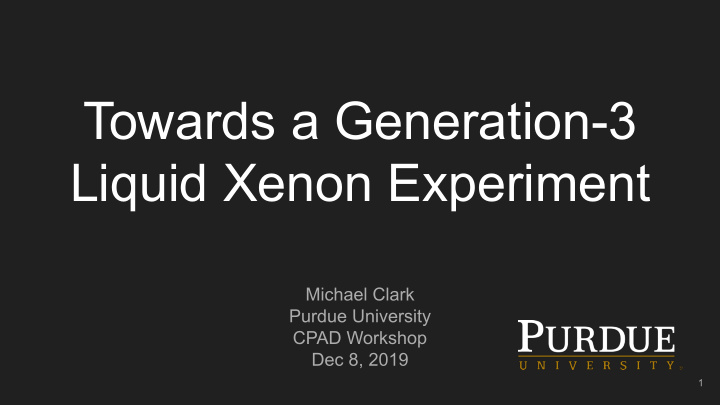



Towards a Generation-3 Liquid Xenon Experiment Michael Clark Purdue University CPAD Workshop Dec 8, 2019 1
Down to the neutrino floor Xenon experiments lead the pack for WIMP detection, and next generation experiments leave parameter space unexplored above the neutrino floor Another order of magnitude Lang, DPF 2019 sensitivity required for a measurement of atmospheric neutrinos 2
Other Science Cases for Generation-3 Lang, DPF 2019 3
Generation-3 Research Directions ● Radon Reduction ● High Voltage ○ Radon Distillation/Filtration ○ Electrodes, Surface Coatings, Drift ○ Surfaces and Coating Field Uniformity, Feedthroughs ○ Hermetic TPC ● Signal Collection ● Hermetic TPC ○ Photon Detection, Localization ○ Structural Materials ● Data Acquisition ○ Wavelength Shifting Coatings ○ Software Trigger, Data Reduction ● Xenon Purification ● Single Electron Background Reduction ○ Online liquid purification ○ Identification ○ Hermetic TPC ○ Mitigation 4
Radon Reduction Rn daughters (214Pb) produce the majority of the background in WIMP searches XENON1T, 2018 Online cryogenic distillation and charcoal adsorption removes Rn from the xenon target Screening materials for low Rn emanation 5
Additional Radon Reduction Techniques ● Surface treatment of materials to remove diffused Rn XENON1T, 2018 ● Coating detector materials to reduce emanation ● Reducing the amount of material in contact with Xe Hermetic TPC ➔ 6
Hermetic TPC PMTs Xe target separated from materials such as light detectors, wires, reflectors and GXe cryostat Reduces the amount of Rn and ➔ impurities that can be introduced from LXe these other materials Enclosing materials need to be ★ transparent to Xe scintillation light LXe 7
Hermetic TPC UCSD is testing a hermetic TPC made of fused silica, but this material is not structurally sound at the size needed for Generation-3 Acrylic could be used but would require a wavelength shifter to allow light signals through the material Ni, TAUP 2019 Sanguino et al., 2016 TPB doesn’t behave well with liquid xenon, so other coatings need to be investigated 8
Liquid Xenon Purification The volume of xenon involved in a Generation-3 experiment makes gas purification impractical Liquid purification is required to reach the required flow rates (tens of liters ➔ per minute) XENONnT will use liquid purification, but more study is needed to find the optimum filtration system and materials with low radon emanation and high adsorption of electronegative impurities 9
High voltage A large TPC requires higher voltage to sustain the required drift and extraction fields over the full TPC volume Requires larger HV feedthroughs ➔ Electrodes (meshes, wires) that can sustain high ➔ voltages (smooth surface) Electrodes made of high resistivity coatings ➔ Ni, TAUP 2019 Graphene-coated Fused silica 10
Signal Collection Must cover a large surface area with detector, while maintaining energy resolution, sensitivity, and position reconstruction Baudis et al., 1808.06827 Low-background Silicon-PMs could be a good option to increase pixel density and reduce radioactivity Development of other technologies sensitive to Xe scintillation, or high efficiency wavelength shifting to visible light 11
Data Acquisition and Event Reconstruction Need to be able to deal with the amount of data coming from the increased number of channels (acquisition, storage, processing) At the same time, moving away from hardware triggering systems towards software triggering and data compression could allow more information to be kept for later use without veto Online analysis of all incoming events to extract the most relevant information ➔ from an event, without needing to save all raw data. 12
Low Energy Backgrounds Low-energy backgrounds need to be well understood to reduce the energy threshold XENON1T, 2018 Single-electron backgrounds are observed many milliseconds after large energy deposits Long time-scales means we must reduce this background through hardware 13
Quenching with IR light At Purdue - Seeking to understand and mitigate these single-electron events as part of the LBECA collaboration IR LED Investigating hypothesis that electrons from high energy events are trapped by impurities or at the liquid-gas interface Low-purity data shows that IR LED increases extracted electrons, but the effect is small, recent improvements to increase light flux 14
Conclusion Generation-3 liquid xenon promises great performance in the future of astroparticle physics R&D is still needed to iron out the technical aspects of design and background reduction 15
Recommend
More recommend